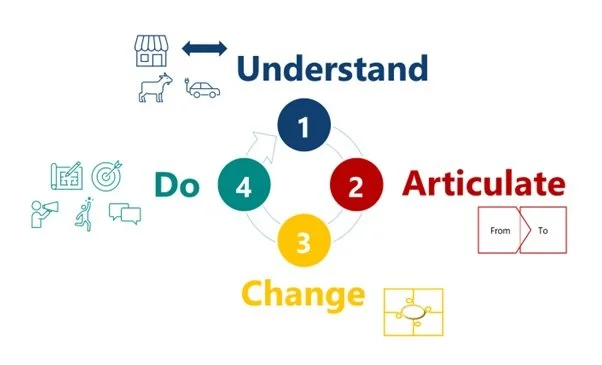Why is building your culture not a project?
Final Thoughts
f you can’t name your culture goals, you don’t have any. Make culture a practice. Not a poster. Build it with the same discipline you bring to your product, your customers, your growth. Because when culture becomes operational, everything else moves faster.
The forgotten project
Culture is your biggest project you just forgot to treat it like one.
You plan strategy. You execute targets. You measure performance. But culture? It drifts. Everyone talks about it. No one owns it. Why is it so hard to “do culture” or “improve our culture”?
The invisible system
Culture sits between strategy and execution and that’s exactly why it gets lost. It’s invisible until it breaks. You see the symptoms: slow decisions, blame, burnout, silos, lack of ownership. But not the cause. The real issue hides in plain sight: how you work together, how you decide, how you handle tension. That’s culture. It’s what happens between the PowerPoint and the daily stand-up. And yet, it rarely gets managed with the same attention as your metrics.
The weather trap
We treat culture like weather: we talk about it, but we don’t design it. We wait for it to “improve” while hoping the next hire or the next offsite will fix the storm. It won’t. Culture is not a vibe. It’s a system of behaviors, rituals, and shared choices. It’s how people interpret priorities when no one is watching. And if it’s not on your roadmap, it’s not real.
If you don't work on your culture, your culture will work on you. Because we believe culture is intangible, it’s that soft thing we can’t touch. It’s time to change that mindset and see culture as a very practical, hands-on thing you can work on.
Measure what matters
Think about it. You have product roadmaps, marketing plans, quarterly OKRs. You have dashboards for almost everything. But where’s your culture dashboard, product and team? How do you know if trust is growing? If ownership is rising? If collaboration is slowing you down or powering you up? If you can’t measure it, you can’t manage it. Culture deserves the same rigor as any other core process.
The fallacy of the quick fix
Let’s be honest: you can’t fix culture in a workshop. You can’t “launch” culture. You can’t fix it with a poster, a slogan, or a new set of values on the wall. But you can build it with the same rhythm as your product: sprints, reviews, iteration. Culture is built through repetition. Through feedback. Through small decisions that accumulate into identity. The mistake? Treating culture as emotion, not as infrastructure. The paradox? Culture needs structure to stay human.
Patterns before posters
When you build a culture project, you don’t start with words. You start with patterns. How are meetings run? Who speaks first? How are mistakes handled? How do decisions actually get made by process, by politics, or by courage? Those patterns define your reality. You can’t coach chaos. You can only design clarity.
Make it operational
Stop romanticizing culture. Start operationalizing it. Bring culture into your goal setting and roadmaps. Design rituals the same way you design features. Because culture work is business work. It shapes how fast you move, how you decide, how people own outcomes. Every delay, every unclear handover, every misaligned expectation that’s culture cost.
If you treat culture as a side project, you’ll pay for it in speed, trust, and talent. But when you treat it as a core project, you create leverage. Teams align faster. Decisions stick. Energy flows. Clarity creates momentum.
The 4-step rhythm
Here’s how we run it, simple, tangible, repeatable:
Understand - Building culture starts from understanding the current culture right now. Knowing how it helps (or doesn’t help) to achieve your strategy. See what’s really driving your current culture. What are the unspoken rules? How do people actually behave, not how you think they behave?
Articulate - From understanding the current culture you define 1 (or 2) clear from-to’s. Shifts you like to make in your culture. Those will be the focus for the next 3-9 months. What behaviors and patterns do you want to shift? Why now? Define what “better” looks like. Less is not just more, its required. Working on 3 topics creates zero impact, working on 1 or 2 topics, might get you great results. Articulation is the mirror moment: honest, sharp, sometimes uncomfortable. Are you really committed to making this from-to happen?
Change - For each from-to we will together define clear interventions. Small significant changes that together will nudge the desired behavior. The tactical pieces of the puzzle that lock in together to create a meaningful change. Design concrete actions: meetings, rituals, roles, decisions. You can’t change everything, but you can change the moments that matter. Maybe you will redesign your weekly review to create ownership. Maybe you shift decision rights. Maybe you kill one meeting and replace it with a real conversation. Maybe you train on how to give feedback, or you create a podium for your leaders to be challenged on the company direction. Interventions make culture visible.
Do - The interventions are translated to a practical action plan. A small team from across the organization is accountable for the follow-through. Treat it like any other project: goals, rhythm, accountability. Create milestones. Review progress. Celebrate change in behavior, not just outcomes. Culture needs a cadence not one big bang, but consistent beats.
From talk to practice
When you run culture like a project, something changes. It stops being abstract. It becomes measurable, manageable, alive. People see progress. Leaders stop talking about culture and start leading it.
If you can’t name your culture goals, you don’t have any. Make culture a practice. Not a poster. Build it with the same discipline you bring to your product, your customers, your growth. Because when culture becomes operational, everything else moves faster.


